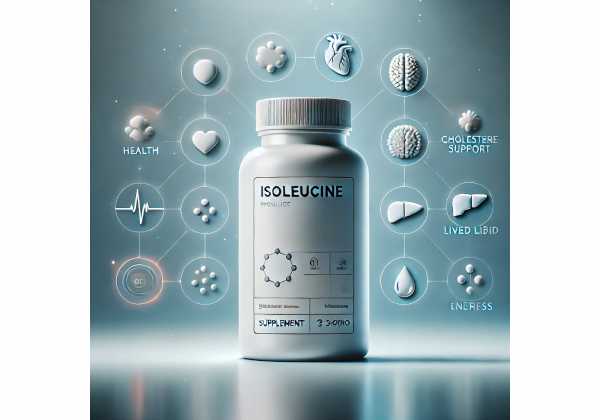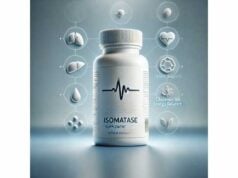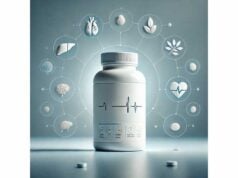
Isoleucine is one of the three branched-chain amino acids (BCAAs) your body cannot make on its own. It helps drive muscle protein building alongside leucine and valine, supports exercise recovery, and contributes to immune function and energy metabolism. Because isoleucine is essential, you must obtain it from food or supplements. Athletes often reach for BCAAs or essential amino acid (EAA) blends around workouts, while clinicians consider isoleucine within overall protein planning for aging, illness, and recovery. This guide translates the science into practical steps: what isoleucine does, where it shines, sensible dosing, how to combine it with diet and training, and when to be careful. You will find clear ranges (mg/kg and grams), real-world examples, and safety guardrails so you can decide whether isoleucine deserves a place in your daily routine.
Fast Facts
- Supports muscle repair and exercise recovery; works best with total protein and training.
- Typical supplemental range: 0.2–0.5 g/kg/day as part of BCAAs or EAAs; single doses of 2–5 g are common in blends.
- Safety caveat: people with kidney disease, liver disease, or maple syrup urine disease require medical guidance.
- Avoid if you have a known BCAA metabolism disorder; pause seven days before surgery unless your surgeon advises otherwise.
Table of Contents
- What is isoleucine and what it does
- Top benefits backed by evidence
- How to use isoleucine: supplements and foods
- How much isoleucine per day?
- Mistakes to avoid and troubleshooting
- Safety: who should avoid it and interactions
- What the research says: a balanced summary
What is isoleucine and what it does
Isoleucine is an indispensable amino acid with a branched side chain, grouped with leucine and valine as the BCAAs. “Indispensable” means your body cannot synthesize it; it must come from the diet. Inside skeletal muscle, isoleucine contributes carbon and nitrogen for building proteins and also serves as a fuel substrate through oxidation. Unlike leucine, which strongly triggers the mTOR pathway to initiate muscle protein synthesis (MPS), isoleucine plays more of a supporting role: it helps supply the full set of essential building blocks so synthesis can continue beyond the initial “signal.” In practical terms, a meal or supplement that provides isoleucine together with the other essential amino acids raises the ceiling for how much new muscle protein your body can manufacture after training or during recovery from illness.
Metabolically, isoleucine is both ketogenic and glucogenic. Its breakdown yields acetyl-CoA and succinyl-CoA, intermediates that feed into energy pathways. This duality helps explain why isoleucine appears in studies on glucose handling, fatigue resistance, and recovery. In the immune system, rapidly dividing cells (like lymphocytes) rely on amino acids for proliferation and function; adequate essential amino acid availability, including isoleucine, supports this response. Isoleucine also contributes to hemoglobin synthesis and may influence nitrogen balance during catabolic stress.
Because BCAAs are heavily metabolized in muscle rather than the liver, they are frequently used around workouts. However, your body does not use isoleucine in isolation in everyday life—it uses a balanced profile of essential amino acids. That is why total daily protein intake from high-quality foods often outperforms isolated BCAA powders for long-term goals such as gaining or maintaining lean mass. Still, isoleucine-containing blends can be useful tools when food is not practical (e.g., during long sessions, when appetite is low, or in clinical contexts like perioperative care under supervision).
At the whole-diet level, isoleucine is abundant in animal proteins (dairy, eggs, meat, fish) and well represented in soy, pea, and other legumes. Blended plant proteins can match animal sources when thoughtfully combined. If you follow a plant-forward diet, focusing on total protein (g/kg/day) and essential amino acid density ensures sufficient isoleucine without overreliance on supplements.
Finally, context matters. Isoleucine works best when paired with the pillars that drive results: progressive resistance training, adequate energy intake, sufficient sleep, and a protein pattern that distributes essential amino acids across meals. Supplements amplify, but they cannot replace, those fundamentals.
Top benefits backed by evidence
1) Muscle recovery and reduced soreness. Trials and meta-analyses examining BCAA supplementation—typically in 2:1:1 (leucine:isoleucine:valine) or similar ratios—show modest reductions in delayed-onset muscle soreness (DOMS) and certain muscle damage markers after unaccustomed or high-volume exercise. Effects are variable: benefits appear more consistently when BCAAs are taken for several days before and after muscle-damaging sessions, when total protein is borderline low, or when training status is novice to intermediate. The magnitude of benefit is modest (think “a bit less sore” or “recover slightly faster,” not dramatic changes), and BCAAs perform best as adjuncts to adequate daily protein and carbohydrates.
2) Support for muscle protein synthesis (MPS) as part of EAAs. Isoleucine contributes substrate for MPS. While leucine is the main “go” signal for mTOR, isoleucine ensures that once the signal is fired, there are enough essential building blocks to extend the MPS response. Practically, complete proteins or balanced EAA mixtures that include isoleucine outperform leucine alone for building new muscle protein, especially beyond the first hour or two post-exercise. This is why whey protein (rich in all EAAs) or EAA blends generally beat BCAAs alone for hypertrophy over months.
3) Energy metabolism and fatigue resistance. BCAAs are oxidized in muscle and can be used as an auxiliary fuel during prolonged exercise. Isoleucine’s glucogenic component may help maintain energy output under certain conditions. Some studies report small improvements in perceived exertion or time-to-exhaustion when BCAAs are taken before endurance work—again, usually when carbohydrate intake is not optimal or in athletes under heavy training stress.
4) Clinical settings and recovery from illness (specialist-directed). Essential amino acids, including isoleucine, are used in medical nutrition to support recovery from surgery, illness, or immobilization. In these contexts, dosing, timing, and product selection are clinician-directed. For the general reader, the takeaway is that ensuring adequate essential amino acids is a core strategy for preserving muscle during periods of stress.
5) Healthy aging and muscle maintenance. As we age, muscle becomes less responsive to anabolic signals (“anabolic resistance”). Distributing 25–40 g of high-quality protein (containing ≥2–3 g leucine and proportionate isoleucine) at each meal can help overcome this. Isoleucine is part of the required pattern that, together with resistance training, helps maintain strength, function, and independence.
6) Blood sugar handling: nuance required. Some experiments suggest that isoleucine can influence glucose uptake in muscle and may modestly affect post-prandial glycemia when taken with other nutrients. However, epidemiologic links between very high circulating BCAAs and metabolic disease reflect downstream metabolism rather than causation by supplements. For most healthy, active people using typical doses, isoleucine within balanced protein intake is unlikely to impair glycemic control; individuals with diabetes should integrate any supplement plan with their care team.
What this means for you. If your diet already supplies enough high-quality protein spaced through the day, isoleucine-containing powders may deliver small, situational benefits—convenience during training windows, slightly less soreness, or a practical way to top up EAAs during heavy blocks. If your overall protein is low or poorly distributed, prioritize food first: doing so moves the needle far more than any isolated amino acid.
How to use isoleucine: supplements and foods
Choose the right format for your goal.
- Complete proteins (whey, casein, milk, soy, pea blends): Best for building or maintaining muscle because they provide all EAAs in effective proportions, including isoleucine. Use after workouts, at breakfast, or when a meal is hard to get.
- EAA blends: Useful when you need the anabolic amino acids without additional calories or lactose. Look for products listing per-serving amounts of each EAA; a typical effective serving provides ~10–15 g EAAs with proportionate isoleucine.
- BCAA powders or capsules: Handy around workouts or during endurance sessions when a light stomach is important. Check the ratio (2:1:1 is common) and total grams per serving.
- Standalone isoleucine: Niche use. Consider only if advised (e.g., part of a medical plan) or when precisely adjusting a custom blend. Most people do better with complete proteins or balanced EAA/BCAA formulas.
Timing matters—but less than totals. Aim to cover three anchors daily:
- Post-exercise feeding within 1–2 hours: a complete protein or EAAs (isoleucine included) to capitalize on elevated MPS.
- Protein distribution across meals: 25–40 g high-quality protein per meal for adults, higher end if you are older or larger.
- Pre-sleep protein on heavy training days: casein or a mixed protein to support overnight repair.
Food sources to prioritize.
- Animal proteins: Whey, Greek yogurt, cottage cheese, eggs, lean meats, and fish provide abundant isoleucine alongside leucine and valine.
- Plant proteins: Soy (tofu, tempeh), edamame, pea protein, lentils, chickpeas, quinoa, buckwheat, and mixed grains/legumes. Blending plant sources (e.g., rice + pea) improves the EAA profile.
- Meal ideas: Oats with Greek yogurt and walnuts; tofu stir-fry with edamame and quinoa; omelet with beans and whole-grain toast; chicken or tempeh bowl with rice and peas.
Stacking tips.
- Carbohydrates with training fuel reduce reliance on BCAA oxidation and can enhance performance and recovery.
- Creatine monohydrate (3–5 g/day) complements protein/EAA strategies for strength and lean mass.
- Electrolytes during long sessions (especially heat) help sustain output when using BCAA beverages.
Label literacy.
- Look for third-party testing and per-amino-acid disclosure.
- Avoid “proprietary blends” that hide exact amounts.
- Note sweeteners and acids (citric/malic) if you have GI sensitivity.
- Keep serving size realistic: some products list 2–3 scoops as “one serving.”
When food wins. If you can eat a full meal within a reasonable window, do that. Use supplements for convenience, appetite constraints, or precise dosing—not as a crutch for a sparse diet.
How much isoleucine per day?
Baselines for healthy adults. International evaluations place the adult isoleucine requirement around ~20 mg/kg/day. For a 70-kg adult, that’s about 1.4 g/day from all dietary sources combined. Most mixed diets meeting overall protein needs exceed this threshold without special planning.
Applied sport and training ranges. For exercise recovery and muscle maintenance, practitioners typically frame intake in two ways:
- As part of total protein: 1.2–2.0 g of protein per kg body weight per day for active individuals, spaced across three to five feedings. This automatically supplies ample isoleucine if protein quality is high.
- As part of EAA/BCAA supplements:
- BCAAs: Common doses are 5–10 g near workouts (2:1:1 or similar ratio), providing ~1.6–3.3 g isoleucine per serving depending on the formula.
- EAAs: 10–15 g EAAs per serving typically include ~1–2 g isoleucine, depending on the specific pattern.
- Standalone isoleucine: If used, 2–5 g per day in divided doses is a cautious, practical range for healthy adults; most users do not need standalone isoleucine when total protein and EAAs are in place.
Older adults (sarcopenia risk). Keep meal protein higher (e.g., 30–40 g), ensuring the EAA profile is complete. You usually will not need separate isoleucine if meals are well planned.
Plant-forward diets. Emphasize EAA-dense plant proteins (soy, pea, blends) and total protein of 1.2–1.6 g/kg/day if you train regularly. Supplement only if meals fall short.
Safety margins and upper limits. There is no universally established tolerable upper intake for isoleucine in healthy adults, but expert reviews of indispensable amino acids suggest conservative upper limits for individual amino acids well above amounts used in sports nutrition, with safety concerns arising first for leucine at very high intakes. In practice, staying within 0.2–0.5 g/kg/day of total BCAAs (from all sources) and using isoleucine as part of balanced patterns keeps most healthy users well within typical research exposures.
Putting numbers into action.
- Recreational lifter, 70 kg: Goal 1.6 g/kg/day protein (≈112 g/day) through meals; optionally add 5–10 g BCAAs or 10–15 g EAAs around tough sessions.
- Endurance athlete during heavy week, 60 kg: Maintain 1.4–1.8 g/kg/day protein through foods; sip 5–7 g BCAAs in a 500–750 mL bottle during long runs if solid food is impractical.
- Plant-based trainee, 80 kg: Aim for 1.6–2.0 g/kg/day with soy/pea blends; use 10–12 g EAAs after workouts on low-appetite days.
Remember: totals over time beat timing tricks. Hitting daily protein targets with high-quality sources, meal after meal, delivers more than any isolated amino acid dose.
Mistakes to avoid and troubleshooting
Mistake 1: Treating BCAAs as a substitute for meals. BCAAs are not complete proteins. Relying on them while skimping on food leads to slower progress. Fix: Center your plan on whole meals or complete proteins; keep BCAAs for narrow windows when food is impractical.
Mistake 2: Mega-dosing single amino acids. Large single-amino-acid intakes can create imbalances because BCAAs share transporters. Fix: Favor balanced patterns (EAAs or complete protein). If using standalone isoleucine, keep doses modest and purposeful.
Mistake 3: Ignoring distribution. Front-loading protein at dinner wastes opportunities earlier. Fix: Aim for three to four protein-rich moments daily, each with ample EAAs.
Mistake 4: Forgetting carbs around training. Amino acids do not replace carbs for performance. Fix: Include carbs before and after sessions to protect training quality and recovery.
Mistake 5: Under-hydrating flavored powders. Concentrated drinks can irritate the GI tract. Fix: Dilute to taste, especially with sour beverages (citrate-based flavors).
Mistake 6: Not checking the label. Proprietary blends, undisclosed per-amino-acid amounts, or unnecessary extras (stimulants) complicate dosing and safety. Fix: Choose transparent labels with third-party testing.
Mistake 7: Expecting big performance jumps. Isoleucine helps recovery and supports MPS but will not substitute for progressive overload, sleep, and energy balance. Fix: Use supplements to fill gaps, not to replace training fundamentals.
Troubleshooting common issues
- Nausea or cramping: Take with a small snack, dilute the drink, or switch flavors/sweeteners.
- No noticeable effect: Reassess your baseline protein, sleep, and training plan. Many users only feel a difference when these basics are weak.
- Weight management goals: Prioritize complete proteins and fiber-rich foods to support satiety; use EAA/BCAA strategically around workouts without displacing real meals.
- Plant-based concerns: Blend protein sources (e.g., soy + pea + grains) and monitor total grams per meal; supplement EAAs if appetite is low.
Safety: who should avoid it and interactions
For healthy adults using moderate doses, isoleucine-containing products are generally well tolerated. That said, amino acids are biologically active and merit respect.
Who should avoid isoleucine supplements unless medically advised
- People with maple syrup urine disease (MSUD) or other inborn errors of BCAA metabolism.
- Individuals with significant kidney or liver disease, unless supplementation is part of a prescribed plan.
- Those preparing for surgery: pause discretionary amino acid supplements seven days prior unless your surgical team instructs otherwise.
- Pregnant or breastfeeding individuals: prioritize food proteins; use specialized formulas only under clinical guidance.
- Children and adolescents: supplements are rarely necessary outside physician-directed care.
Potential side effects (usually mild and dose-related)
- GI upset, bloating, or nausea when powders are too concentrated.
- Headache or restlessness if products contain added stimulants or high artificial sweeteners.
- Rarely, acne flares in susceptible individuals during high-dose use (often due to overall dietary pattern rather than amino acids alone).
Drug and condition interactions
- Diabetes or glucose-lowering therapy: amino acids can influence post-prandial glucose and insulin responses. Coordinate supplement timing with your clinician.
- Thyroid and seizure medications: maintain consistent meal and supplement timing; report any changes to your prescriber.
- Chemotherapy or specialized medical nutrition: only use clinician-approved products; timing relative to treatment may matter.
Quality and contamination risks
- Choose brands with independent testing for identity, purity, and heavy metals.
- Avoid powders with undisclosed “proprietary” blends.
- Store in a cool, dry place; reseal promptly to prevent clumping and degradation.
When to stop and seek care
- New or worsening swelling, breathing difficulty, severe abdominal pain, black/tarry stools, marked weakness, or confusion.
- Any unusual neurological symptoms or rapid weight changes not explained by training/diet.
Bottom line: in responsible doses and within a complete nutrition plan, isoleucine is a useful tool for recovery and muscle maintenance. High-risk groups should rely on clinician guidance, and everyone should prioritize food first.
What the research says: a balanced summary
Across decades of nutrition science, three practical points emerge about isoleucine:
1) Requirements are modest—and easily met with a good diet. Adult isoleucine needs hover around 20 mg/kg/day, which normal mixed diets surpass if protein is adequate. Foods with complete EAA profiles (dairy, eggs, meat, fish, soy) make hitting this target straightforward. For most people, diligent meal planning obviates the need for standalone isoleucine.
2) For training, complete proteins and EAAs beat BCAAs alone over time. BCAAs can modestly reduce soreness and perceived fatigue under certain conditions, but they lack the full complement of EAAs needed to sustain maximal MPS for hours. For hypertrophy or muscle retention, total protein intake and quality dominate outcomes; BCAAs are best treated as situational helpers (e.g., during long endurance sessions or when appetite is low).
3) Safety is favorable at typical intakes, with common-sense caveats. Most healthy adults tolerate standard EAA/BCAA doses well. Problems arise when people megadose single amino acids, disregard existing medical conditions, or use low-quality products. Sensible ranges, transparent labeling, and attention to whole-diet context keep risk low.
How to apply the evidence today
- If you train hard: Aim for 1.6 g/kg/day of total protein with balanced meals. Consider 10–15 g EAAs after lifting or 5–10 g BCAAs during long endurance work when solid food is impractical.
- If you are plant-based: Blend protein sources and track per-meal totals; supplement EAAs on low-intake days.
- If you are older: Push meal protein higher and pair it with resistance training; complete proteins or EAAs will cover isoleucine needs.
- If you have a medical condition: Ask your clinician before adding any amino acid product; medical nutrition can be powerful but must be individualized.
Taken together, the literature supports a clear message: isoleucine matters, but it matters most as part of a complete protein pattern aligned with your training, health status, and goals. Use it to fine-tune—not to replace—the fundamentals.
References
- Oral Branched-Chain Amino Acids Supplementation in Sports and Exercise: A Systematic Review and Meta-Analysis (2022) (Systematic Review)
- Attenuating Muscle Damage Biomarkers and Muscle Soreness with Branched-Chain Amino Acid Supplementation: A Meta-analysis (2024) (Systematic Review)
- Branched-chain amino acid requirements in healthy adult men determined by the indicator amino acid oxidation technique (2006)
- Identifying recommended dietary allowances for protein and amino acids: a critique of the 2007 WHO/FAO/UNU report (2012)
- Tolerable Upper Intake Level for Individual Amino Acids in Humans (2023) (Review)
Medical Disclaimer
This guide is educational and does not replace personalized medical advice, diagnosis, or treatment. Speak with your healthcare professional before starting or changing any supplement, especially if you are pregnant or breastfeeding, have kidney or liver disease, diabetes, or a metabolic disorder, or take prescription medications. If you choose to use isoleucine or BCAA/EAA supplements, select reputable products, follow label directions, and discontinue use if you experience concerning symptoms.
If this article helped you, please consider sharing it on Facebook, X, or your preferred platform, and follow us for future evidence-based guides. Your support helps us continue creating clear, people-first resources.










